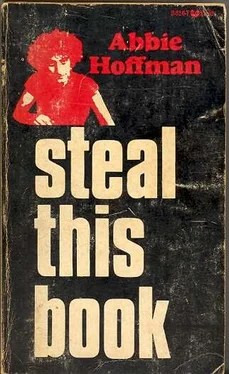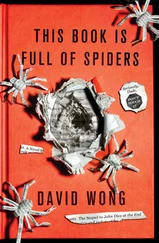Chaos resulting from the gassing, clubbing and shooting associated with a police riot also makes personal first aid important. Most demonstrations have medical teams that run with the people and staff mobile units, but often these become the target of assault by the more vicious pigs. Also, in the confusion, there is usually too much work for the medical teams. Everyone must take responsibility for everyone else if we are to survive in the streets. If you spot someone lying unconscious or badly injured, take it upon yourself to help the victim. Immediately raise your arm or wave your Nation flag and shout for a medic. If the person is badly hurt, it is best not to move him, or her, but if there is the risk of more harm or the area is badly gassed, the victim should be moved to safety. Try to be as gentle as possible. Get some people to help you.
Your attitude in dealing with an injured person is extremely important. Don’t panic at the sight of blood. Most bloody injuries look far worse than they are. Don’t get nervous if the victim is unconscious. If you’re not able to control your own fear about treating someone, call for another person. It helps to attend a few first aid classes to overcome these fears in practice sessions.
When you approach the victim, identify yourself. Calmly, but quickly figure out what’s the matter. Check to see if the person is alive by feeling for the pulse.
There are a number of spots to check if the blood is circulating, under the chin near the neck, the wrists, and ankles are the most common. Get in the habit of feeling a normal pulse. A high pulse (over 100 per minute) usually indicates shock. A low pulse indicates some kind of injury to the heart or nervous system.
Massaging the heart can often restore the heartbeat, especially if its loss is due to a severe blow to the chest. Mouth-to-mouth resuscitation should be used if the victim is not breathing. Both these skills can be mastered in a first aid course in less than an hour and should become second nature to every street fighter.
When it comes to dealing with bleeding or possible fractures, enlisting the victim’s help as well as adopting a firm but calm manner will be very reassuring.
This is important to avoid shock. Shock occurs when there is a serious loss of blood and not enough is being supplied to the brain. The symptoms are high pulse rate; cold, clammy, pale skin; trembling or unconsciousness. Try to keep the patient warm with blankets or coats. If a tremendous amount of blood has been lost, the victim may need a transfusion. Routine bleeding can be stopped by firm direct pressure over the source of bleeding for 5 to 10 minutes. If an artery has been cut and bleeding is severe, a tourniquet will be needed. Use a belt, scarf or torn shirtsleeve. Tie the tourniquet around the arm or leg directly above the bleeding area and tighten it until the bleeding stops. Do not loosen the tourniquet. Wrap the injured limb in a cold wet towel or ice if available and move the person to a doctor or hospital before irreparable damage can occur. Don’t panic, though, you have about six hours.
A painful blow to a limb is best treated with an ice pack and elevation of the extremity by resting it on a pillow or rolled-up jacket. A severe blow to the chest or side can result in a rib fracture which produces sharp pains when breathing and/or coughing up blood. Chest X-rays will eventually be needed. Other internal injuries can occur from sharp body blows such as kidney injuries. They are usually accompanied by nausea, vomiting, shock and persistent abdominal pain.
If you feel a bad internal injury has occurred, get prompt professional help.
Head injuries have to be attended to with more attention than other parts of the body. Treat them by stopping the bleeding with direct pressure. They should be treated before other injuries as they more quickly can cause shock. Every head injury should be X-rayed and the injured person should be watched for the next 24 hours as complications can develop hours after the injury was sustained. After a severe blow to the head, be on the look-out for excessive sleepiness or difficulty in waking. Sharp and persistent headaches, vomiting and nausea, dizziness or difficulty maintaining balance are all warning signs. If they occur after a head injury, call a doctor.
If a limb appears to be broken or fractured, improvise a splint before moving the victim. Place a stiff backing behind the limb such as a board or rolled-up magazine and wrap both with a bandage. Try to avoid moving the injured limb as this can lead to complicating the fracture. Every fracture must be X-rayed to evaluate the extent of the injury and subsequent treatment.
Bullet wounds to the abdomen, chest or head, if loss of consciousness occurs are extremely dangerous and must be seen by a doctor immediately. If the wound occurs in the limb, treat as you would any bleeding with direct pressure bandage and tourniquet only if nothing else will stop the bleeding.
If you expect trouble, every person going to a street scene should have a few minimum supplies in addition to those mentioned in the section on Demonstrations for protection. A handful of bandaids, gauze pads (4x4), an ace bandage (3 inch width), and a roll of 1/2 inch adhesive tape can all easily fit in your pocket. A plastic bag with cotton balls pre-soaked in water will come in handy in a variety of situations where gas is being used, as will a small bottle of mineral oil. You should write the name, phone number and address of the nearest movement doctor on your arm with a ballpoint pen. Your arm’s getting pretty crowded, isn’t it? If someone is severely injured, it may be better to save their life by taking them to a hospital, even though that means probable capture for them, rather than try to treat it yourself. However, do not confuse the police with the hospital. Many injured people have been finished off by the porkers, and that’s no joke. It is usually better to treat a person yourself rather than let the pigs get them, unless they have ambulance equipment right there and don’t seem vicious. Even then, they will often wait until they get two or three victims before making a trip to the hospital.
If you have a special medical problem, such as being a diabetic or having a penicillin allergy, you should wear a medi-alert tag around your neck indicating your condition. Every person who sees a lot of street action should have a tetanus shot at least once in every five years.
Know just this much, and it will help to keep down serious injuries at demonstrations. A few lessons in a first aid class at one of the Free Universities or People’s Clinics will go a long way in providing you with the confidence and skill needed in the street.
Here is a partial list of some Medical Committees for Human Rights. They will be glad to give you first aid instructions and often organize medical teams to work demonstrations. A complete list is available from the Chicago office.
• BALTIMORE, MARYLAND, 21215—6012 Wallis Ave.
• BERKELEY, CALIFORNIA, 94609—663 Alcartz
• BIRMINGHAM, ALABAMA, 35205—2122 9th Ave. South
• CHICAGO, ILLINOIS—1512 E. 55th St.
• CLEVELAND, OHIO, 44112—Outpost, 13017 Euclid Ave.
• DETROIT, MICHIGAN, 48207—1300 E. Lafayette
• HARTFORD, CONN., 06112—161 Ridgefield St.
• LOS ANGELES, CALIF.—PO Box 2463, Sepulveda, Calif. 91343 (mail)
• NASHVILLE,TENN., 37204—3301 Leland Land
• NEW HAVEN, CONN.,—30 Bryden Terrace, Hamden, Conn. 06514 (mail)
• NEW ORLEANS LA., 70130—623 Bourbon St.
• NEW YORK, NY 10014—15 Charles St.
• PHILADELPHIA, PA., 19119—6705 Lincoln Drive
• PITTSBURGH, PA., 15222—617 Empire Building
Читать дальше












